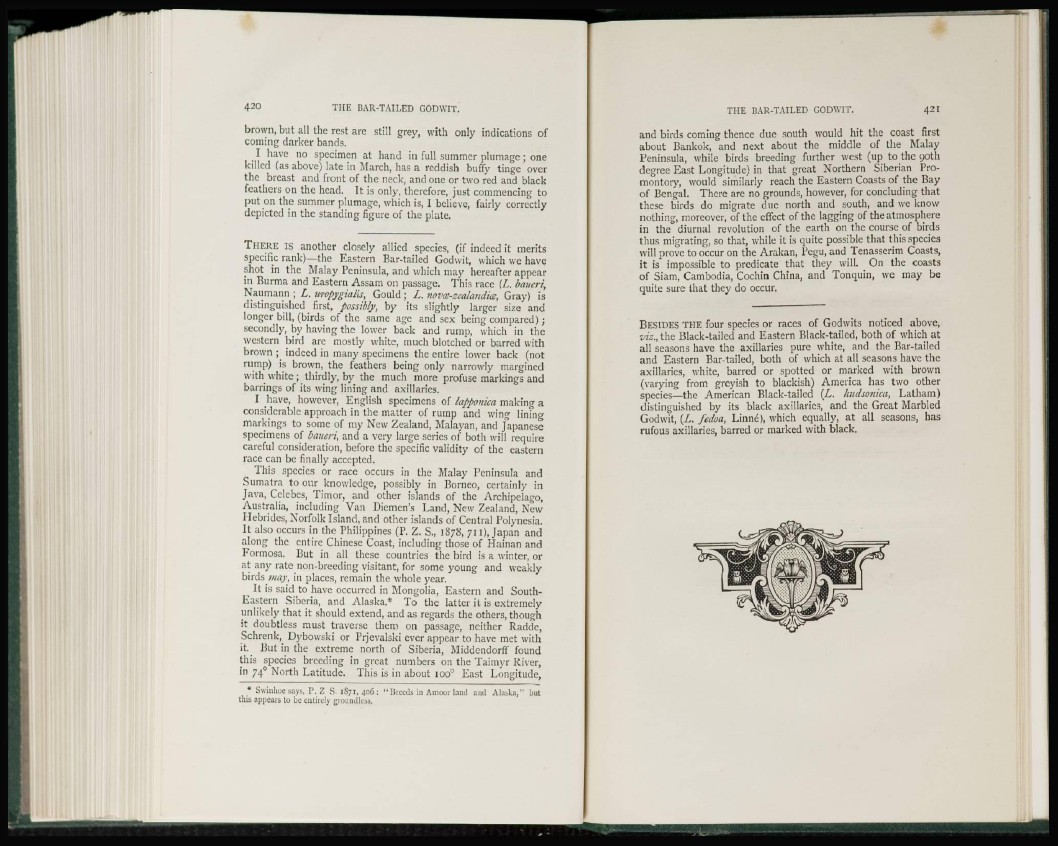
brown, but all the rest are still grey, with only indications of
coming darker bands.
_ I have no specimen at hand in full summer plumage; one
killed (as above) late in March, has a reddish buffy tinge over
the breast and front of the neck, and one or two red and black
feathers on the head. It is only, therefore, just commencing to
put on the summer plumage, which is, I believe, fairly correctly
depicted in the standing figure of the plate.
THERE IS another closely allied species, (if indeed it merits
specific rank)—the Eastern Bar-tailed Godwit, which we have
shot in the Malay Peninsula, and which may hereafter appear
in Burma and Eastern Assam on passage. This race (L. baueri,
Naumann ; L . uropygialis, Gould ; L. novre-scalandia;, Gray) is
distinguished first, possibly, by its slightly larger size and
longer bill, (birds of the same age and sex being compared);
secondly, by having the lower back and rump, which in the
western bird are mostly white, much blotched or barred with
brown ; indeed in many specimens the entire lower back (not
rump) is brown, the feathers being only narrowly margined
with white ; thirdly, by the much more profuse markings and
barrings of its wing lining and axillaries.
I have, however, English specimens of lapponica making a
considerable approach in the matter of rump and wing lining
markings to some of my New Zealand, Malayan, and Japanese
specimens of baueri, and a very large series of both will require
careful consideration, before the specific validity of the eastern
race can be finally accepted.
This species or race occurs in the Malay Peninsula and
Sumatra to our knowledge, possibly in Borneo, certainly in
Java, Celebes, Timor, and other islands of the Archipelago,
Australia, including Van Diemcn's Land, New Zealand, New
Hebrides, Norfolk Island, and other islands of Central Polynesia.
It also occurs in the Philippines (P. Z. S., 1878, 711), Japan and
along the entire Chinese Coast, including those of Hainan and
P'ormosa. But in all these countries the bird is a winter, or
at any rate non-breeding visitant, for some young and weakly
birds may, in places, remain the whole year.
It is said to have occurred in Mongolia, Eastern and South-
Eastern Siberia, and Alaska.* To the latter it is extremely
unlikely that it should extend, and as regards the others, though
it doubtless must traverse them on passage, neither Radde,
Schrenk, Dybowski or Prjcvalski ever appear to have met with
it. But in the extreme north of Siberia, Middendorff found
this species breeding in great numbers on the Taimyr River,
in 7 4 0 North Latitude. This is in about ioo° East Longitude,
* Swinhoe says. P. Z S. 1S71, 406: " Breeds in Arooor land and Alaska," but
this appears to be entiiely groundless.
and birds coming thence due south would hit the coast first
about Bankok, and next about the middle of the Malay
Peninsula, while birds breeding further west (up to the 90th
degree East Longitude) in that great Northern Siberian Promontory,
would similarly reach the Eastern Coasts of the Bay
of Bengal. There arc no grounds, however, for concluding that
these birds do migrate due north and south, and we know
nothing, moreover, of the effect of the lagging of the atmosphere
in the diurnal revolution of the earth on the course of birds
thus migrating, so that, while it is quite possible that this species
will prove to occur on the Arakan, Pegu, and Tenasserim Coasts,
it is impossible to predicate that they will. On the coasts
of Siam, Cambodia, Cochin China, and Tonquin, we may be
quite sure that they do occur.
BESIDES THE four species or races of Godwits noticed above,
via., the Black-tailed and Eastern Black-tailed, both of which at
all seasons have the axillaries pure white, and the Bar-tailed
and Eastern Bar-tailed, both of which at all seasons have the
axillaries, white, barred or spotted or marked with brown
(varying from greyish to blackish) America has two other
species—the American Black-tailed (L. hudsonica, Latham)
distinguished by its black axillaries, and the Great Marbled
Godwit, (L. fedoa, Linné), which equally, at all seasons, has
rufous axillaries, barred or marked with black.